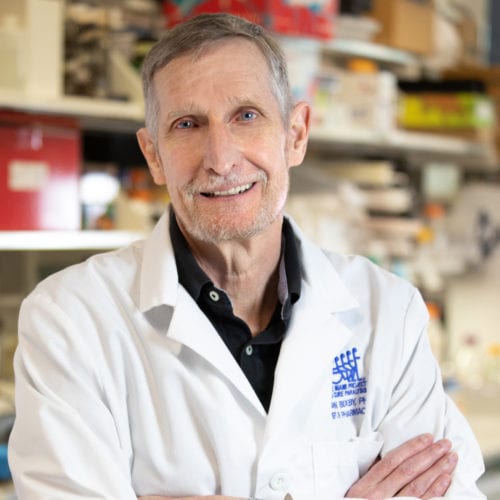John L. Bixby, Ph.D.
Professor Emeritus, Departments of Molecular and Cellular Pharmacology and Neurological Surgery

The Miami Project to Cure Paralysis
1095 NW 14th Terrace (R-48)
Miami, FL 33136
Biography
Research Interests
Areas Of Research
Publications
More
Dr. John L. Bixby received his PhD from Caltech in 1980, and did postdoctoral work at the University of California, San Diego, and the University of California, San Francisco (UCSF). He joined the faculty at UCSF in 1985 and moved to the University of Miami in 1988. He is Professor emeritus of Molecular & Cellular Pharmacology and Neurological Surgery at the Miller School of Medicine and The Miami Project to Cure Paralysis. He was Sr. Associate Dean for Graduate & Postdoctoral Studies at the School of Medicine from 2006-2012, and was Vice Provost for Research of the University of Miami from 2012-2020.
His research interests are in axon growth and regeneration, neuronal gene expression and epigenetics, and high throughput analysis of neuronal morphology for CNS drug development; the lab is also involved in efforts to improve FAIR data sharing. In addition to NIH U01 and T32 grants, Dr. Bixby received uninterrupted support as an NIH R01 PI from 1990-2022, as well as multiple grants from the NSF, the State of Florida, and various research foundations; his current grants include an NIH UH3. His 130+ journal publications include multiple articles in top-ranked journals such as Science, Nature, and Proc. Natl. Acad. Sci (USA). He has extensive experience reviewing grant proposals for the NIH (24 distinct study sections), the NSF (2 different review panels), and other organizations, including the Swiss National Science Foundation, the Howard Hughes Medical Institute, Wings for Life, Craig Nielsen Foundation, and the Wellcome Trust.
Dr. Bixby has collaborated closely with Dr. Vance Lemmon since they joined their laboratories in 2003, and they have collaborated with Dr. Hassan Al-Ali since 2012.
Phenotypic Screening, Axon Regeneration, and Drug Discovery
Transcription factors in Axon Growth
Our focus is on understanding and overcoming barriers to axon regeneration after injury to the central nervous system (CNS). We use various strategies to identify and manipulate molecular targets to promote this regeneration. When Dr. Vance Lemmon and I established our joint lab in 2003, we adopted two core technologies: phenotypic screening and transcriptomics. This combination was powerful and resulted in the identification of KLF family members as important regulators of CNS axon regeneration (Moore et al, 2010, Science, 326: 298; Blackmore et al, 2012, PNAS (USA) 109: 7517). We also did extensive work on other transcription factors such as STAT3 and Jun family members (Smith et al, 2011, Mol Cell Neurosci 46: 32; Lerch et al, 2014, Mol Cell Neurosci, 59: 97; Luo et al, 2016, Cell Rep, 15: 398; Mehta et al, 2016, Exp Neurol, 280: 115; Danzi et al, 2018, Mol Cell Neurosci 92: 114).
Kinases in Axon Growth
In the past 12 years or so, we have focused increasingly on the roles of kinases in CNS regeneration. Kinases regulate most aspects of cell function, including axon growth and regeneration. Because of their critical roles in cancer, there are many drugs and compounds as well as cDNA and RNAi libraries that can be used to interrogate the kinome. We have done a large kinase overexpression screen in primary hippocampal neurons (Buchser et al, 2010, Molec Syst Biol 6: 391). Besides identifying interesting individual targets for further study, our pathway and gene ontology analysis of these results led to a surprise. Kinase pathways involved in cancer are also important in regulating axon growth!
Kinase Inhibitors for Drug Discovery
More recently, together with Dr. Hassan Al-Ali, we have been using kinase inhibitors (KIs) to identify target (those to inhibit) and liability (those to avoid) kinases to promote regeneration (Al-Ali et al, 2015, ACS Chem Biol 10: 1939; Beckerman et al, 2015, Assay Drug Dev Technol 13: 377; Al-Ali et al., 2017, J Neurosci 37: 7079; Patel et al, 2020, PNAS (USA) 117: 33597). This work exploits KI polypharmacology, combining biochemical profiling of KIs with their phenotypic effects, using bioinformatic and machine learning approaches. This approach has led us to identify a KI that enhances axon growth/regeneration in vivo, which we are developing into a potential therapeutic with the help of a Blueprint Neurotherapeutics (UG3/UH3) grant from NIH/NINDS.
Rigor and Reproducibility
For some time, we have been concerned about rigor and reproducibility in SCI research. In 2012, we organized “Growth Cones and Axon Regeneration: Entering the Age of Informatics”, a meeting supported by the NICHD/NINDS U.S.-JAPAN Brain Research Cooperative Program. At that meeting the participants began work on “Minimum Information About a Spinal Cord Injury Experiment”, a reporting standard for the SCI field (Lemmon et al, 2014, J. Neurotrauma, 31:1354). Together with Dr. Ubbo Visser, we subsequently developed an ontology and knowledgebase for the SCI domain (Callahan et al, 2016, Database (Oxford), Apr 7, pii: baw040; Lemmon et al, 2014, Neural Regeneration Research 9: 6). We have helped organize other workshops and meetings on this issue (Fouad et al, 2020, J Neurotrauma, 37: 831; Callahan et al, 2017, Exp Neurol, 295:135), served on the Executive Board (now on the Community Board) of the Open Data Commons for Spinal Cord Injury (odc-sci.org), and are part of the “Pan-Neurotrauma Data Commons” which will unify the ODC-SCI with the ODC-TBI, funded by a U24 grant from NINDS.
Visit Dr. Bixby’s Publication Listing
News Stories
NIH/NINDS Blueprint Neurotherapeutics Network Grant (April 2022)
On the Edge of Discovery (12/2019)
Understanding the Challenges of Re-connecting Neurons after Spinal Cord Injury (10/2019)
Turbo Charging Discovery with High-Content Screening (09/2019)
Industry and Academia: Drs. John Bixby, Vance Lemmon and Hassan Al-Ali (10/2016)
Bunge and Bixby Publish Paper in Science (03/2015)
PROFESSIONAL AFFILIATIONS/MEMBERSHIPS
Society for Neurosciences
American Association for the Advancement of Science
